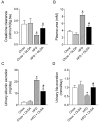Activation of TRPV1-Expressing Renal Sensory Nerves of Rats with N-Oleoyldopamine Attenuates High-Fat-Diet-Induced Impairment of Renal Function
- PMID: 37047183
- PMCID: PMC10094377
- DOI: 10.3390/ijms24076207
Activation of TRPV1-Expressing Renal Sensory Nerves of Rats with N-Oleoyldopamine Attenuates High-Fat-Diet-Induced Impairment of Renal Function
Abstract
Enhanced renal sympathetic nerve activity (RSNA) contributes to obesity-induced renal disease, while the role of afferent renal nerve activity (ARNA) is not fully understood. The present study tested the hypothesis that activating the transient receptor potential vanilloid 1 (TRPV1) channel in afferent renal nerves suppresses RSNA and prevents renal dysfunction and hypertension in obese rats. N-oleoyldopamine (OLDA, 1 ng/kg, daily) was administrated intrathecally (T8-L3) via an indwelled catheter to chronically activate, TRPV1-positive afferent renal nerves in rats fed a chow diet or high-fat diet (HFD) for 8 weeks. HFD intake significantly increased the body weight, impaired glucose and insulin tolerance, decreased creatinine clearance, and elevated systolic blood pressure in rats compared with the levels of the chow-fed rats (all p < 0.05). An intrathecal OLDA treatment for 8 weeks did not affect the fasting glucose level, glucose tolerance, and insulin tolerance in rats fed either chow or HFD. As expected, the chronic OLDA treatment significantly increased the levels of plasma calcitonin gene-related peptide and substance P and ARNA in the HFD-fed rats (all p < 0.05). Interestingly, the OLDA treatment decreased the urinary norepinephrine level and RSNA in rats fed HFD (both p < 0.05). Importantly, the OLDA treatment attenuated HFD-induced decreases in creatinine clearance and urinary Na+ excretion and increases in the plasma urea level, urinary albumin level, and systolic blood pressure at the end of an 8-week treatment (all p < 0.05). Taken together, the intrathecal administration of OLDA ameliorates the enhancement of RSNA, renal dysfunction, and hypertension in obese rats. These findings shed light on the roles of TRPV1-positive renal afferent nerves in obesity-related renal dysfunction and hypertension.
Keywords: N-oleoyldopamine; TRPV1; high-fat diet; hypertension; obesity.
Conflict of interest statement
The authors declare no conflict of interest.
Figures





Similar articles
-
Ablation of TRPV1 Abolishes Salicylate-Induced Sympathetic Activity Suppression and Exacerbates Salicylate-Induced Renal Dysfunction in Diet-Induced Obesity.Cells. 2021 May 18;10(5):1234. doi: 10.3390/cells10051234. Cells. 2021. PMID: 34069822 Free PMC article.
-
Activation of TRPV1 improves natriuresis and salt sensitivity in high-fat diet fed mice.Biochem Pharmacol. 2022 Sep;203:115190. doi: 10.1016/j.bcp.2022.115190. Epub 2022 Jul 26. Biochem Pharmacol. 2022. PMID: 35905972
-
TRPV1 Activation Prevents Renal Ischemia-Reperfusion Injury-Induced Increase in Salt Sensitivity by Suppressing Renal Sympathetic Nerve Activity.Curr Hypertens Rev. 2020;16(2):148-155. doi: 10.2174/1573402115666191112122339. Curr Hypertens Rev. 2020. PMID: 31721716 Free PMC article.
-
Knockout of TRPV1 Exacerbates Left Ventricular Diastolic Dysfunction Induced by A High-fat Diet in Mice.Cardiovasc Hematol Disord Drug Targets. 2018;18(3):215-223. doi: 10.2174/1871529X18666180503124538. Cardiovasc Hematol Disord Drug Targets. 2018. PMID: 29732984
-
Endothelin in the control of renal sympathetic nerve activity.Contrib Nephrol. 2011;172:107-119. doi: 10.1159/000328688. Epub 2011 Aug 30. Contrib Nephrol. 2011. PMID: 21893993 Review.
Cited by
-
From fat to filter: the effect of adipose tissue-derived signals on kidney function.Nat Rev Nephrol. 2025 Jun;21(6):417-434. doi: 10.1038/s41581-025-00950-5. Epub 2025 Apr 2. Nat Rev Nephrol. 2025. PMID: 40175570 Review.
References
MeSH terms
Substances
Grants and funding
LinkOut - more resources
Full Text Sources
Medical
Research Materials

